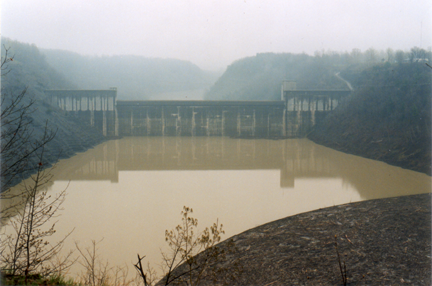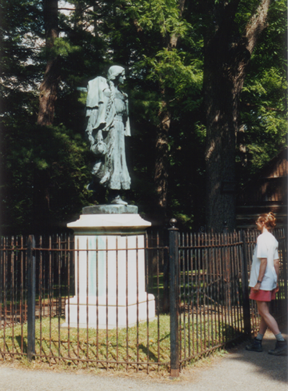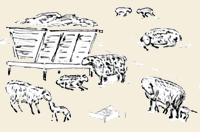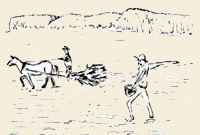|
Genesee Vignettes
Personal Reflections on the Genesee River
A series of eighteen essays by
Essay VI. The Mount Morris Dam
Essay VII. Childhood Memories of Letchworth
VI. The Mount Morris Dam
Until the 1960s RIT was located downtown, west of the river. But in 1961
its postwar metamorphosis into a true university—coupled with the
disruptions that constructing the Inner Loop was going to cause—led
to a decision to move. By the end of the decade RIT had built a new campus
for itself on 1,300 acres of Henrietta farmland.
The new campus turns out to be quite different from the campuses I had
known as a student. Rhodes College, Georgia Tech, and Johns Hopkins were
each surrounded by residential communities, with restaurants and small
businesses interspersed, all within easy walking distance. But at RIT
only the parking lots are within easy walking distance, and much of the
campus perimeter has been develped as an industrial and business park.
To a significant extent, land use at RIT has been dictated by topography.
Despite the modest high ground that supports the main buldings, the site
is basically a flood plain. South of the high ground, then east and north
flows a small creek, flanked by wetlands, and—more significantly—a
few hundred yards to the west flows the Genesee.
What keeps the campus—and much of Rochester—protected from
regular flooding is the Mount Morris Dam. Stretching across the gorge
at the northern end of Letchworth State Park, the Mount Morris Dam was
built by the U. S. Army Corps of Engineers during the heyday of American
dam building in the mid-twentieth century. Although modest in scale relative
to other dams built by the Army Engineers (or by their rivals at the U.
S. Bureau of Reclamation), it's still quite a sight.
Much of the year the dam has no water behind it. Instead, the river meanders
along the canyon floor and passes freely beneath the huge concrete structure.
Only then does it enter a year-round impoundment, created by a much smaller
dam a short distance downstream (a hydroelectric facility, owned by the
Rochester Gas and Electric Company). But whenever floodwaters threaten
the Genesee Valley to the north, the excess is held behind the Mount Morris
Dam, creating a temporary lake in the Letchworth gorge. Not until the
threat subsides is the temporary lake drained.
During the spring of 1996 Terry and I explored the terrain of one of
these recently drained lakes. As the trail dipped into the portion of
the valley that had been under water a short time before, our surroundings
changed dramatically. We had been hiking through hillside woods. But the
few trees we now saw around us had had their limbs stripped or oddly twisted,
and the ground was covered with a sticky, clay-colored mud that noticeably
slowed our pace. Eventually the trail rose again, and after clambering
over the pile of logs and branches left behind as the water level had
dropped, Terry took a picture—looking upsteam—across the desolate
landscape of the recent lake bed:

When we returned a month later, the valley had again been transformed
into a lake. This time our trail followed the valley rim and took us to
the dam itself. From one of the overlooks, we could see through the mist
of low-hanging clouds the concrete wall that now blocked the river's flow.
Also in view, just upriver from the dam, was a mass of logs and tree branches,
corralled in the graceful arc of a boom:

From our hikes we had developed a sense of how much water could be held
back. Yet we hadn't seen the most extreme case. A diagram in the parking
area west of the dam showed the height the water reached after Hurricane
Agnes in 1972—all the way up to the spillway. In the Southern Tier
the result was widespread flooding—in Grandma Cornell's barn, in
Campbell, for example, and further downstream (on a much more destructive
scale) in Corning, New York. But because of the Mount Morris Dam, Rochester
wasn't seriously affected.
VII. Childhood Memories of Letchworth
At first glance what you see at Letchworth is the state park. After paying
the required entrance fee and picking up a map, you drive along two-lane
blacktop at speeds well under the interstate speeds that got you from
Rochester to Mount Morris, New York. Here and there, shoulders of greensward
give way to parking lots for picnic areas, trailheads, or sites for viewing
the river gorge, and—if you've come at the height of the summer
season—you see cars and people everywhere.
Where the crowds situate the park very much in the present, the roadside
stonework situates it in the past—going back to the Civilian Conservation
Corps during the Great Depression of the 1930s. Going back even further
is the Glen Iris Inn, overlooking the Middle Falls. Originally built by
William Pryor Letchworth in the late nineteenth century, the Glen Iris
and its grounds became the core of the park when Mr. Letchworth donated
his property to the state in 1907.
The park includes other notable man-made structures. In the previous
essay I described how the dam at the northern end functions as part of
Rochester's flood-control system. What appears at the southern end are
transportation systems that originated in the nineteenth century. High
above the Upper Falls is the iron trestle that still carries freight trains
traveling between New York City and Buffalo, and along the eastern edge
of the gorge—from the Civil War parade grounds to the aqueduct abutment
near Portageville, New York—lies the bed of the old Genesee Valley
Canal.
In addition to man-made features, of course, Letchworth has features
bestowed by nature. Here, since the end of the last Ice Age, the river
has fought its way down the Allegheny Plateau, passing over a series of
waterfalls and through a deep canyon that opens—at Mount Morris—into
a broad, preglacial valley. Here also you can see impressive forests,
not just new growth on former fields but also occasional pockets of old-growth—including
ancient red cedars that cling to the canyon walls.
Still other features of Letchworth involve Native Americans. A Seneca
trail once crossed the river just upstream from the Upper Falls, and located
a short distance from the Glen Iris is a Seneca council house which was
moved to the park from its original site near the village of Caneadea,
New York. Next to the council house is a statue of Mary Jemison, a white
captive of the Senecas who later chose to remain with her captors. For
many years Jemison lived on the Gardeau Flats—now part of the park—and
every September a Native American festival is held at Letchworth in her
honor.

Terry and I have enjoyed exploring all these features of the park. For
example, on a hot July day in 1993 we exchanged our unair-conditioned
house for the cooler surroundings of the woods at Letchworth. After a
picnic we went through the museum near the Glen Iris and then walked up
the hill to see Jemison's statue. Also that year we attended the festival
in her honor. Outside the museum we watched a flint knapper at work, and
in the area between the statue and the council house we listened to a
traditional Iroquois storyteller. Finally, at the main festival site we
enjoyed watching baskets being made.
But my earliest memory of Letchworth after moving to Rochester turns
out not to be an actual event at all. Instead, it's a fantasy I had during
my first quarter at RIT.
Before coming to RIT, I had acquired a modest amount of teaching experience.
As a lab assistant at Rhodes College and at Georgia Tech I had helped
students with their physics experiments and graded their lab notebooks.
Then as a teaching assistant for a history of science course at Johns
Hopkins I had led weekly discussion sessions for the students and graded
their essay exams. Nevertheless, my courses at RIT during the Fall Quarter
1982 were the first I had taught completely on my own—which meant
writing, from scratch, three different sets of lectures. Never before
had I opened up, digested, and written about so much new material in such
a short span of time.
As the end of the quarter approached, I began imagining how I might grade
the final exams under more relaxing circumstances. "What if I rented
a cabin at Letchworth?" I asked myself. "I could take the students'
blue books with me, and as breaks from the grading I could walk in the
surrounding woods or put another log on the fireplace fire." Although
I quickly realized I was too busy to make the necessary arrangements,
just the thought of a Letchworth retreat provided solace—and somehow
I got the grades turned in, on time.
Along the way, my fantasy brought to the surface what seemed to be real
images of a cabin in cold weather and raccoons in the night. But not until
I began writing this essay did I telephone my parents to confirm the reality
of a childhood visit to the park. "It was in the fall of 1956, after
Bill was born in July," Mom said. Then Dad added: "I was a new
employee at Monsanto, in Dayton [Ohio]. I hadn't taken a vacation and
had to take one before the end of the year. We went over Columbus Day
weekend."
Back and forth my parents continued, thus generating for me an overall
account of the trip. "We left Bill with my parents in Youngstown,"
Mom recalled, "and I think we stopped at Presque Isle [near Erie,
Pennsylvania] on the way." Then came one of the parts I remembered.
"Those cabins were stone cold," Dad said. "We opened the
door of the electric oven. Gradually that—and the fire in the fireplace—warmed
up the room."
When Mom mentioned photographs from the trip, Dad explained: "My
pictures were taken on Ektachrome, and those slides have all faded. Ektachrome
was the thing to use at the time, because it was faster than Kodachrome.
I'll see if I can locate for you the ones I took on the trip." Sure
enough, he found them and had copies made—and one of them confirmed
my other memory. It's a nightime shot, showing me on the porch—at
the edge of a flash-created circle of light—intent on feeding a
pair of raccoons:

Illustrations supplied by author.
| 


